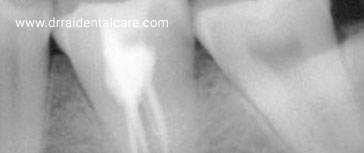

Root canal therapy is the treatment of the pulp of the tooth. It is necessary when the pulp, containing the nerves and blood supply of the tooth, is diseased or damaged. The whole objective of a root canal is to save your tooth by treating the infection. The only other alternative is to remove your tooth and replace it with an artificial one.
To understand why you might need a root canal, we need to first explain the anatomy of a tooth. A normal healthy tooth consists of three layers. The enamel, which is the hardest part of the tooth. The dentine, which is softer than the enamel and carries branches of the nerve of the tooth. And the pulp, a soft center tissue containing blood vessels, nerves and connective tissue.
The most common cause of pulpal infection is a deep, decaying cavity. Other possibilities could be repeated dental procedures, physical trauma to the tooth such as a fall or blow which need not be accompanied by a visible sign, a crack, chip or fracture of the tooth and even advanced gum (periodontal) disease
If pulp inflammation or infection is left untreated, it can cause severe pain and toothache, eventually leading to an abscess. Besides being very painful, an abscess can cause damage to the bone around the tooth. Hence, the tooth should be treated by root canal therapy or it could be lost.
* Sometimes, however there may be no symptoms.
Root canal therapy involves removing the diseased or dead pulp and replacing it with a substance that prevents re-infection. Before any treatment, a thorough examination is done and x-rays of the tooth are taken. Although each case is different, here's what we generally follow at our clinic.
To make the patient comfortable, and the procedure painfree, an anaesthetic may be given. Occasionally, a small protective sheet (rubber dam) may be used to isolate the affected tooth, and keep it clean and free of saliva.
The tooth is drilled, all the decay and old or broken fillings are removed and the opening is extended into the pulp. This is called 'making of the access cavity'.
After the unhealthy pulp tissue is removed, the canals are cleaned and shaped with very delicate, sterilized, instruments called endodontic files. In order to assess the cleaning, x-rays are taken with the files in place.
Once the cleaning is complete the root canals are filled with an intermediate medication and the cavity is sealed with cement filling. After a few days, the healing is re-assessed. If infection persists, the tooth may need to be re-medicated.
Once the infection has subsided, the root canals are filled and sealed with a material called 'gutta-percha' which ensures complete sealing of the root canal system and prevents any re-infection.
Once the root canal is complete, the cavity is filled with a permanent filling. In some cases where the tooth is badly broken down, a post is made and inserted into the root canal to support the filling. Finally, a crown is placed over the tooth to protect it.
Root canal treatment usually takes 2-3 visits. The length of each visit and the duration between visits will depend on the nature of work to be performed and the extent of infection. In some cases where there is no infection and root canal treatment is performed from a restorative point of view, the procedure can be completed in one visit.
Most of the pain associated with a root canal is felt before treatment. In some cases the tooth is highly sensitive while in others a throbbing pain is felt which may be accompanied by a swelling. There is usually some difficulty in eating.
The actual treatment itself is not necessarily painful. In cases with hypersensitivity, an anaesthetic injection is given to numb the area after which the patient usually does not feel anything. In cases with severe infection, antibiotics are prescribed to control the infection and hence the pain.
For the first few days after treatment, the tooth may feel sensitive, specially if there was a lot of pain or infection before treatment. If so, you may be advised a painkiller or even antibiotics.
Damage to the pulpal tissue may occur without any pain and hence go undetected for months or even years. There may have been prior pain, but because it was brief it could have been forgotten. Your dentist may advise a root canal based on the following observations:
Although currently pain free, if left untreated a damaged tooth could eventually flare up. If a root canal is advised, it is in your best interest to have the tooth treated before further damage occurs.
A small percentage of root canals may get re-infected due to the following reasons:
In some cases the infection persists or recurs around the tooth even after routine root canal therapy has been completed. In such cases it becomes necessary to surgically access the infection through the gum and bone tissues and clean it out from around the root of the tooth. This is called "Surgical Root Canal Therapy" (SRCT).
There are different types of endodontic surgeries. The most common is the Apicoectomy where an opening is made in the gum region of the problem tooth and the infected tissue removed along with a part of the root. The end of the remaining root is then sealed with a small filling, stitches are made in the gum tissue and healing generally proceeds uneventfully.
Other types of endodontic surgeries include:
1. Curettage (removing of only inflamed tissue)
2. Root Amputation (selected removal of roots)
3. Hemisection (dividing the tooth in half)
4. Intentional Replantation (removing and reinserting the tooth)
It is important to evaluate the healing process after root canal treatment. This is normally done 6-9 months after completing your treatment. You are requested to return for the follow-up appointment, during which your tooth is examined and an x-ray taken to evaluate the healing.
If properly performed and under normal circumstances, a root canal treated tooth can last you a lifetime.